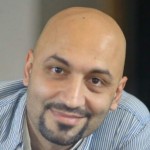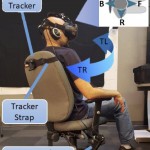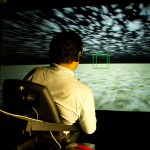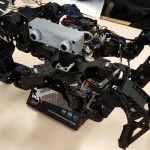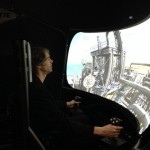Abraham Hashemian
Biography
Abraham is a Ph.D. student in School of Interactive Arts & Technology (SIAT) at Simon Fraser University (SFU) with a background in computer science. He is interested in UX/UI research in virtual, augmented, and mixed realities. Moreover, he is interested in immersive game design regarding his knowledge and prior experiences.
Background: After finishing his M.Sc. in Artificial Intelligence (AI) at 2003, Abraham taught for 12 years as a university instructor, while focusing on game design (for the first 5 years) and Holographic interface design (for the next 5 years) as his field of research. In 2015, he started his Ph.D., focusing on designing interfaces for navigation within virtual environments. Please check his personal website for more details.
Projects
Can more embodied and leaning-based interfaces help support concurrent locomotion and interaction in VR when physical walking isn't feasible?
Physical walking is often considered the gold standard for VR travel whenever feasible. However, especially for larger-scale virtual travel the free-space walking areas are typically too small, thus requiring handheld controllers to navigate, which ...
Hand-held VR controllers are widely available and used, however they can contribute to unwanted side-effects, such as increased cybersickness, disorientation, and cognitive load. Here, we show how a leaning-based interfaces ("HeadJoystick") can help improve user experience, usability,and performance in diverse ground-based navigation including three complementary tasks: reach-the-target, follow-th...
Flying has been a dream for mankind for millenia - but flying interfaces for VR, gaming, and teleoperation (e.g., drones) typically rely on cumbersome double-joystick/gamepads and do not allow for intuitive and embodied flying experiences. Here, we develop low-cost embodied flying interfaces that adapt leaning-based motion cueing paradigms thus freeing up hands for additional tasks beyond just na...
Gamifying Research - Researchifying Games
While traditional experimental paradigms offer tight stimulus control and repeatability, then tend to be a bit boring and removed from many real-world situations, which can limit real-world transferability of results.
How can we bring together the methodological strenghs of research with the intrinsic motivation of playfulness and gaming?
The ...
How do we best design locomotion interfaces for VR that provide "enough" physical motion cues (vestibular/proprioceptive) while still being effective, affordable, compact, and safe?
Despite amazing progress in computer graphics and VR displays, most affordable and room-sized VR locomotion interfaces provide only little physical motion cues (e.g., vestibular & proprioceptive cues). To provide...
Developing virtual interfaces for embodied tele-operation and locomotion.
How can we best design and implement an embodied telepresence system for tele-robotics, so we can safely explore remote, hard-to-reach, or potentially hazardous areas or situations?
The goal of the "TeleSpider" project is to design and implement a telepresence system where users can remotely operate a robotic spid...
Using motion seats for enhancing locomotion and immersion in VR
How can we provide a "moving experience" through VR without having to use a full-scale motion platform?
Could a compact and relatively low-cost "motion seat" provide some of the same benefits, thus reducing cost, complexity, space & safety requirements?
Despite considerable advances in Simulation and Virtual Real...
Publications
http://ispace.iat.sfu.ca/wp-content/plugins/zotpress/
37904
Kitson, Alexandra, Ekaterina R. Stepanova, Abraham M. Hashemian, et al. 2016. “TeleSpider: Investigating Motion-Cueing Interfaces for Control of a Remote Robotic Spider.” Project exhibition. Consumer Virtual Reality (CVR) conference, Vancouver, BC, Canada, Vancouver, BC, Canada, May 14.
37904
Hashemian, Seyedebrahim, Bernhard E. Riecke, Markus von der Heyde, and Ernst Kruijff. 2022. Head joystick interface system and methods thereof. Patent WO2022061468A1 (provisional patent), issued March 31, 2022.
https://patents.google.com/patent/WO2022061468A1.
37904
Kitson, Alexandra, Thinh Nguyen-Vo, Abraham M. Hashemian, Ekaterina R. Stepanova, and Bernhard E. Riecke. 2017. “A User Study Comparing Two Low-Cost Chair Interfaces for Embodied Virtual Locomotion.” Talk presented at the Psychonomic Society 58th Annual Meeting, Vancouver, BC, Canada, November.
37904
Hashemian, Abraham M., and Bernhard E. Riecke. 2017. “Rotate and Lean: Does Leaning toward the Target Direction Improves the Virtual Reality Navigation?” Poster presented at the Second International Workshop on Models and Representations in Spatial Cognition, Tübingen, Germany, April 6.
37904
Riecke, Bernhard E, Abraham M Hashemian, Ashu Adhikari, Ivan Aguilar, Ernst Kruijff, and Markus von der Heyde. 2021. “Simultaneous Locomotion and Interaction in VR: Walking > Leaning > Controller.” Talk presented at the ICSC 2021: 8th International Conference on Spatial Cognition, Rome, Italy.
https://youtu.be/jzoaBAd6gPY.
37904
Adhikari, Ashu, Bernhard E. Riecke, Abraham M. Hashemian, Thinh Nguyen-Vo, Ernst Kruijff, and Markus von der Heyde. 2021. “Embodied VR Flying Improves Spatial Orientation While Reducing Cybersickness.” Talk presented at the ICSC 2021: 8th International Conference on Spatial Cognition, Rome, Italy.
https://youtu.be/FbmE4SEISWU.
37904
Hashemian, A. M., & Riecke, B. E. (2017). Leaning-Based 360° Interfaces: Investigating Virtual Reality Navigation Interfaces with Leaning-Based-Translation and Full-Rotation. In S. Lackey & J. Chen (Eds.),
Virtual, Augmented and Mixed Reality (VAMR 2017) (Vol. 10280, pp. 15–32). Springer.
https://youtu.be/7IT9EODJn3c
37904
Hashemian, Abraham M., Ashu Adhikari, Alexander Bretin, Ivan Aguilar, Ernst Kruijff, Markus von der Heyde, and Bernhard E. Riecke. 2021. “Is Walking Necessary for Effective Locomotion and Interaction in VR?” In 2021 IEEE Conference on Virtual Reality and 3D User Interfaces Abstracts and Workshops (VRW), 395–96. Lisbon, Portugal: IEEE. https://doi.org/10.1109/VRW52623.2021.00084.
37904
Hashemian, Abraham M., Alexandra Kitson, Thinh Nguyen-Vo, Hrvoje Benko, Wolfgang Stuerzlinger, and Bernhard E. Riecke. 2018. “Investigating a Sparse Peripheral Display in a Head-Mounted Display for VR Locomotion.” In 2018 IEEE Conference on Virtual Reality and 3D User Interfaces (VR), 571–72. Reutlingen, Germany: IEEE. https://doi.org/10.1109/VR.2018.8446345.
37904
Hashemian, Abraham M, Ashu Adhikari, Ivan A Aguilar, Ernst Kruijff, Markus von der Heyde, and Bernhard E. Riecke. 2024. “Leaning-Based Interfaces Improve Simultaneous Locomotion and Object Interaction in VR Compared to the Handheld Controller.” IEEE Transactions on Visualization and Computer Graphics (TVCG) 30 (8): 4665–82. https://doi.org/10.1109/TVCG.2023.3275111.
37904
Adhikari, Ashu, Abraham M. Hashemian, Thinh Nguyen-Vo, Ernst Kruijff, Markus von der Heyde, and Bernhard E. Riecke. 2021. “Lean to Fly: Leaning-Based Embodied Flying Can Improve Performance and User Experience in 3D Navigation.” Frontiers in Virtual Reality 2: 1–22. https://doi.org/10.3389/frvir.2021.730334.
37904
Hashemian, Abraham M., Ashu Adhikari, Ernst Kruijff, Markus von der Heyde, and Bernhard E. Riecke. 2021. “Leaning-Based Interfaces Improve Ground-Based VR Locomotion in Reach-the-Target, Follow-the-Path, and Racing Tasks.” IEEE Transaction on Visualization and Computer Graphics TVCG, 1–22. https://doi.org/10.1109/TVCG.2021.3131422.
37904
Hashemian, A., M. Lotfaliei, A. Adhikari, E. Kruijff, and Bernhard E. Riecke. 2020. “HeadJoystick: Improving Flying in VR Using a Novel Leaning-Based Interface.” IEEE Transactions on Visualization and Computer Graphics 28 (4): 1792–809. https://doi.org/10.1109/TVCG.2020.3025084.
